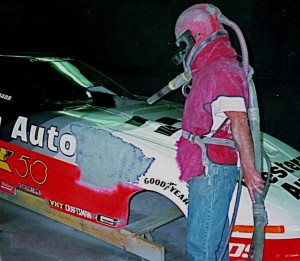Today, the average vehicle is made up of more types of substrates than ever seen before, including steel, aluminum, plastics, composites and fiberglass. This makes the removal of coatings from any type of vehicle very difficult. In addition, paint systems are more complex than ever before. EPA regulations have stimulated a new breed of coatings for painters to learn to use. All of these new coatings, as well as the ones currently being used, behave questionably when applied over existing paint.
Paint manufacturers offer performance statements that read, “when applied over a properly prepared surface…”. The method of choice for creating this surface is Plastic Media Blasting. It is the recommended method for stripping all Ford and General Motors vehicles.
Plastic Media Blasting is a process for the rapid, economic and safe removal of coatings from almost any surface without the use of toxic chemical strippers, sandblasting, or hand or mechanical abrasion methods. The process is similar in principle to sandblasting. However, instead of using hard silica sand, much softer reusable plastic particles are used at low blasting pressures of 14-40 psi. At these pressures, the plastic media is able to remove coatings without causing damage to the underlying substrates including aluminum, fiberglass, and even plastics.
Types of media. Composition Materials Plasti-Grit Plastic Media is available in 5 different types to meet the requirements of specific automobile finishes and substrates. The individual plastic particles are irregular in configuration with granular surfaces that incorporate sharp, angular edges. During use, an effective cutting, shearing and lifting action results.
Due to the plastic media’s unique physical characteristics, it removes build-up without etching, marring, warping, or otherwise damaging delicate substrates, thus preserving vital surface integrity.
The media tends to fracture and break as it impacts on the work surface in such a way that the particles retain their sharp cutting edges. Thus, as the media breaks down, it retains its paint removing ability until the particles are practically dust, which is collected by the plastic media blasting reclaiming and cleaning system. Since the media is made from inert, non-toxic materials, the collected residue and paint fines can usually be safely disposed of in any landfill. The waste of up to 100 complete cars usually fits in a 55 gallon drum. The plastic leaves no residue or film on the work surface. This eliminates the need to use cleaning agents after paint removal, as is required with some other stripping methods.
Air pressure. The high air pressure settings typical of sandblasting operations (usually 60 to 100 psi) are not employed. At these pressures, sandblasting produces rapid paint removal but at the cost of serious substrate damage, such as warping, pitting and stretching. It is the combination of high delivery pressure along with the high particle density of silica sand, copper slag and other hard abrasives which causes the damage to occur so quickly.
Plastic media blasting, on the other hand, is performed at much lower pressures (14-40 psi). Low delivery pressure coupled with the low particle density of plastic media enable the process to be safely utilized for applications where harder and heavier abrasives would cause serious harm.
From an economic standpoint, plastic media blasting offers many advantages, especially to medium and large sized shops. One fo the biggest expenses in preparing a vehicle for repainting is the cost of labor. Stripping and prepping a vehicle for a complete paint job can often take two workers two full days using mechanical or chemical removal methods. Using plastic media blasting, the same task can be accomplished by one operator in as little as 3 hours.
The initial cost of setting up a plastic media blasting system is relatively high compared to other methods. However, because the media can be reclaimed, cleaned of contaminants, and reused so often, the operating costs of using plastic become very competitive.
Equipment costs can vary widely, depending on the size and level of sophistication of the system. Smaller systems can be obtained for under $20,000. Of course, as the size, complexity, and volume of work increase, so do the equipment requirements.
It is important that the equipment be designed for plastic media for the process to operate effectively. Sand blasting equipment simply converted to be used with plastic media often propels the plastic media with too great a force and not enough volume. This will damage the vehicle as well as pulverize the media.
To successfully install and operate a plastic media blasting system, careful attention must be paid to all aspects of the process, including: equipment, blasting media, type of substrates being stripped, training, and ongoing support from the equipment and media manufacturer.


